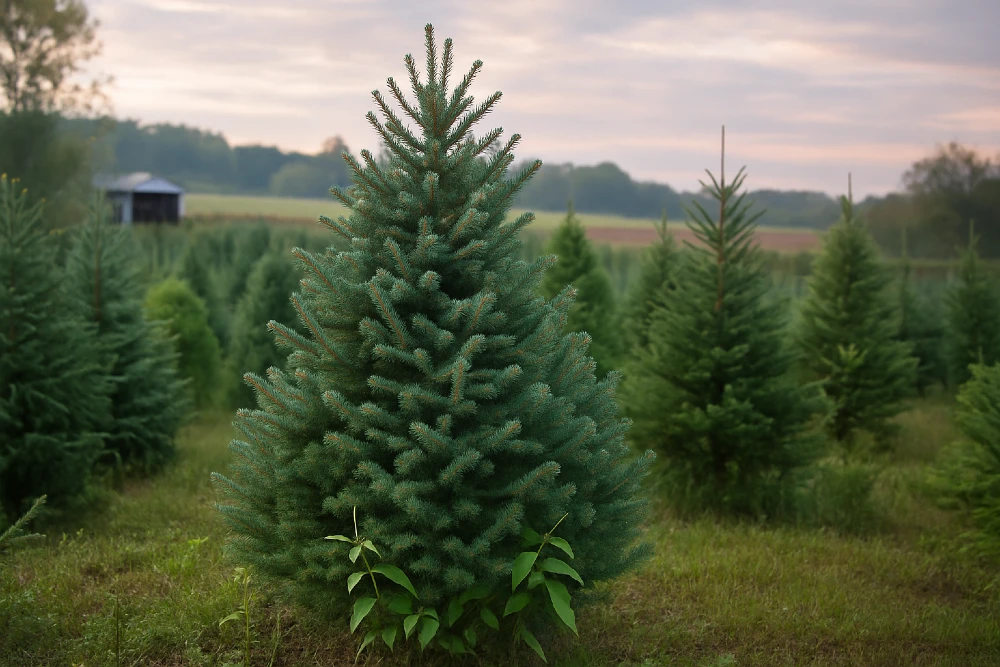White Spruce Christmas Tree Guide

Is the White Spruce a Good Christmas Tree?
If you’re trying to choose the best Christmas tree, start with our Ultimate Guide To Buying a Christmas Tree . Among the classic evergreens you’ll find at farms across Canada and the northern U.S. is the White Spruce Christmas Tree — a hardy, handsome option with a long tradition.
Families who select a White Spruce often love its full, natural form and strong branches that can hold even heavy ornaments. Its bluish-green color gives it a cool winter charm, though its fragrance is subtler than a balsam or Fraser fir. For some, that’s a plus — less scent competing with holiday baking — but be aware that if the needles are crushed, they can give off a sharper, less pleasant odor.
Pros:
- Naturally conical, full shape with dense branching
- Short, stiff needles with attractive bluish-green hue
- Strong branches that can hold heavier ornaments
- Hardy and widely available in northern regions
Cons:
- Needle retention is only “good for a spruce,” not as strong as most firs
- Crushed needles can release an unpleasant odor
- Less common in warmer markets compared to Fraser Fir or Douglas Fir
Bottom line: the White Spruce is a solid choice, especially in colder climates, and it brings a distinct northern character to the season.
Description & Common Characteristics of the White Spruce
The White Spruce (Picea glauca) is a native North American evergreen, found across Canada and the northern United States. Its needles are short (about ½–¾ inch), stiff, and four-sided, with a forest-green to bluish tint. When strung with lights, that cool tone creates a frosted, wintry look. The branches are dense and sturdy, making it easy to decorate with heavier ornaments or layered garlands.
The tree’s cones are slim and cylindrical, hanging gracefully from the branches, and its overall silhouette is pyramidal, tapering neatly to a pointed crown. Historically, White Spruce has been a mainstay of northern communities because of its adaptability: it thrives where few other Christmas tree species can.
Interestingly, while White Spruce has that classic Christmas look, its fragrance is much weaker than firs or even Blue Spruce. For families who want the “Christmas smell,” this is a tradeoff. For others, especially those sensitive to strong scents, it’s perfect.
Needle Retention & Fragrance
How well does the White Spruce hold up indoors? Compared to other spruces, it performs fairly well — its needles stay on longer than Colorado Blue Spruce, but not as long as firs like Fraser or Balsam. That means with good watering, you can expect it to last through the main holiday season without major mess.
Fragrance-wise, it’s subtle. If you crush a needle, it can release a pungent odor (which is why some call it “skunk spruce”), but otherwise, it’s not strongly scented. If fragrance is a priority, a fir might be better; if not, the White Spruce still delivers the holiday look.
Where Do White Spruce Christmas Trees Grow?
In the wild, White Spruce grows throughout Canada and across the northern tier of the U.S., from New England to the northern Rockies. It’s especially common in the boreal forests, where it thrives in cold, well-drained soils.
On farms, White Spruce is cultivated widely across Canada — in provinces like Québec, Ontario, and Alberta — and in northern U.S. states such as Minnesota, Wisconsin, and Michigan. Its cold hardiness makes it a reliable crop where more tender trees might fail. By contrast, White Pine prefers slightly different soils and produces softer, longer needles, while Blue Spruce shares the White Spruce’s hardiness but offers a stronger fragrance.
How Much Does a White Spruce Christmas Tree Cost?
Prices for White Spruce trees are similar to other regional farm-grown spruces and pines, usually a bit lower than premium firs like Fraser. Average ranges are:
- Small (4–5 ft): $40–$65
- Medium (6–7 ft): $65–$100
- Large (8–10 ft): $100–$160+ depending on farm and region
Choose-and-cut farms often price by the foot, while pre-cut trees in urban lots may carry a markup for transport. Because White Spruce is locally grown in northern climates, it’s often more affordable in those regions compared to imported firs.
How to Care for a White Spruce Christmas Tree
Want your White Spruce to last through the season? Follow this checklist:
- Make a fresh cut at the base before placing it in the stand.
- Water daily — this species still needs consistent hydration.
- Place away from heat sources like fireplaces, radiators, or direct sunlight.
- Handle branches gently — crushed needles can release that sharper odor.
- Vacuum occasionally if some needles shed — especially later in the season.
With proper care, your White Spruce should hold its needles for 3–4 weeks indoors.
Where to Find a White Spruce Christmas Tree Near You
Ready to bring one home? Many farms in Canada and the northern U.S. offer White Spruce among their Christmas tree selections. Whether you want the charm of a choose-and-cut experience or the convenience of a pre-cut lot, you’ll find local options.
Explore fresh, farm-grown trees in our Christmas tree farms directory.